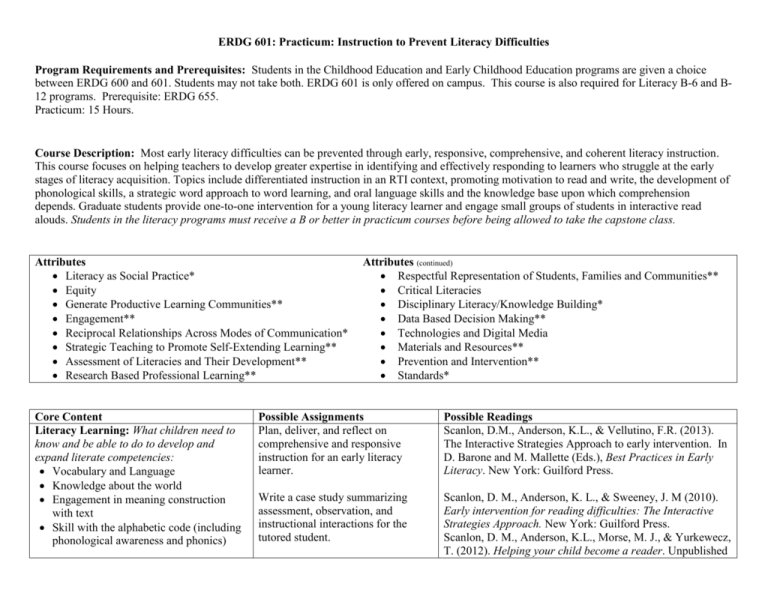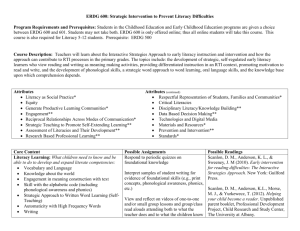ERDG 601 Practicum: Instruction to Prevent Literacy Difficulties
advertisement

ERDG 601: Practicum: Instruction to Prevent Literacy Difficulties Program Requirements and Prerequisites: Students in the Childhood Education and Early Childhood Education programs are given a choice between ERDG 600 and 601. Students may not take both. ERDG 601 is only offered on campus. This course is also required for Literacy B-6 and B12 programs. Prerequisite: ERDG 655. Practicum: 15 Hours. Course Description: Most early literacy difficulties can be prevented through early, responsive, comprehensive, and coherent literacy instruction. This course focuses on helping teachers to develop greater expertise in identifying and effectively responding to learners who struggle at the early stages of literacy acquisition. Topics include differentiated instruction in an RTI context, promoting motivation to read and write, the development of phonological skills, a strategic word approach to word learning, and oral language skills and the knowledge base upon which comprehension depends. Graduate students provide one-to-one intervention for a young literacy learner and engage small groups of students in interactive read alouds. Students in the literacy programs must receive a B or better in practicum courses before being allowed to take the capstone class. Attributes Literacy as Social Practice* Equity Generate Productive Learning Communities** Engagement** Reciprocal Relationships Across Modes of Communication* Strategic Teaching to Promote Self-Extending Learning** Assessment of Literacies and Their Development** Research Based Professional Learning** Core Content Literacy Learning: What children need to know and be able to do to develop and expand literate competencies: Vocabulary and Language Knowledge about the world Engagement in meaning construction with text Skill with the alphabetic code (including phonological awareness and phonics) Attributes (continued) Respectful Representation of Students, Families and Communities** Critical Literacies Disciplinary Literacy/Knowledge Building* Data Based Decision Making** Technologies and Digital Media Materials and Resources** Prevention and Intervention** Standards* Possible Assignments Plan, deliver, and reflect on comprehensive and responsive instruction for an early literacy learner. Possible Readings Scanlon, D.M., Anderson, K.L., & Vellutino, F.R. (2013). The Interactive Strategies Approach to early intervention. In D. Barone and M. Mallette (Eds.), Best Practices in Early Literacy. New York: Guilford Press. Write a case study summarizing assessment, observation, and instructional interactions for the tutored student. Scanlon, D. M., Anderson, K. L., & Sweeney, J. M (2010). Early intervention for reading difficulties: The Interactive Strategies Approach. New York: Guilford Press. Scanlon, D. M., Anderson, K.L., Morse, M. J., & Yurkewecz, T. (2012). Helping your child become a reader. Unpublished Strategic Approach to Written Word Learning (Self-Teaching) Automaticity with High Frequency Words Writing Engaging in Conversations Motivation and self-efficacy Literacy Teaching: Responsive teaching based on sensitive observations and productive organization: Understanding the complexity of the reading process Creating a Comprehensive/balanced Literacy Program Promoting coherence/coordination across learners’ instructional contexts Read alouds for comprehension and oral language development Shared and Interactive Reading Small group supported reading Independent /Silent Reading Modeled, Shared and Independent Writing Organization across tiers of instruction /intervention Strategy Instruction with gradual release of responsibility/self regulation Responsive Teaching Instructional Conversations NYS Curriculum for CCLS Plan and implement thematic unit in a read aloud context. parent booklet, Professional Development Project, Child Research and Study Center, The University at Albany. http://www.isaprofessionaldevelopment.org/documents/Paren t%20Booklet%202012%20color.pdf. Beck, I.L., McKeown, M.G., & Kucan, L. (2013). Bringing words to life: Robust vocabulary instruction. New York: Guilford. Cummins, J. (2011). Literacy engagement: Fueling academic growth for English learners. The Reading Teacher, 65(2), 142-146. Protacio, M. S. (2012). Reading motivation: A focus on English learners. Reading Teacher, 66(1), 69-77. doi: 10.1002/TRTR.01092. Kieffer, M. J., & Lesaux, N. K. (2007). Breaking Down Words to Build Meaning: Morphology, Vocabulary, and Reading Comprehension in the Urban Classroom. The Reading Teacher, 61(2), 134-144. doi: 10.1598/RT.61.2.3 Funk, A. (2012). The Languages of New York State: A CUNY-NYSIEB Guide for Educators. New York, NY: The Graduate Center, City University of New York. Instructional and Assessment Materials/Tools: Books for different purposes Common Core Learning Standards NYS English Language Arts Assessments Observation and Record Keeping Techniques / Strategies Lesson Planning (standardized throughout the department) Screening, Diagnostic and Progress monitoring assessments Running records review Contexts of Learning: Home/School Connections Instructional Environments Students with Special Needs Discourse Patterns (Dialogue/Monologue) within and across contexts Productive Learning Spaces Teaching/Learning as Inquiry Collaboration, Problem Solving and Examining Assumptions Reflective Teaching Ways of Organizing for Ongoing Development Self-Extended Learning Accessing and Evaluating TechnologyRelated Resources










